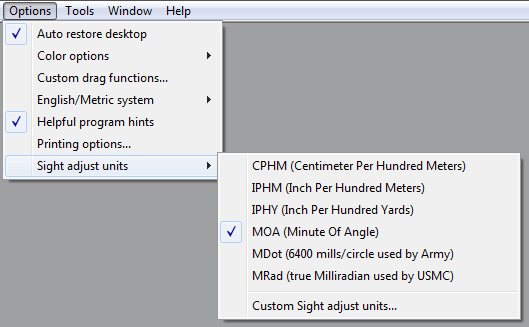|
Sight Adjust Units
|
||
|
Click Options on the main menu and then click Sight adjust units to open a sub menu that lets you pick from six standard units, or click Custom Sight adjust units to create up to 10 of your own units. This allows you create units that match the clicks of various scopes, such as 2 or 4 clicks per MOA..
|
 |
|
|
• CPHM (Centimeter Per Hundred Meters) The selected option is used everywhere in the program as shown below.
CPHM (Centimeter Per Hundred Meters): If range is in meters then CPHM makes things simple if working in the Metric system. A change of 1 CPHM changes the impact point of a bullet by 1 centimeter at 100 meters, 2 centimeters at 200 meters, 3 centimeters at 300 meters and so on. CPHM divides a full circle into 62,832 parts. CPHM is also 0.1 milliradian. IPHM (Inch Per Hundred Meters): If range is in meters as it is in some competitions, then IPHM makes things simple. A change of 1 IPHM changes the impact point of a bullet by 1 inch at 100 meters, 2 inches at 200 meters, 3 inches at 300 meters and so on. IPHM divides a full circle into 24,737 parts. IPHY (Inch Per Hundred Yards): Shooters often round off the MOA value of 1.047 inches per hundred yards to 1 inch, but that starts to create a significant error at longer ranges. Thus, IPHY was invented and is sometimes called the shooter's MOA or SMOA. A change of 1 IPHY changes the impact point of a bullet by 1 inch at 100 yards, 2 inches at 200 yards, 3 inches at 300 yards and so on. IPHY divides a full circle into 22,619 parts. MOA (Minute Of Angle) is a standard unit of angle used in science and engineering. A circle is divided into 360 degrees and each degree is divided into 60 minutes for a total of 21,600 minutes of angle in a circle. Most optical sights are calibrated in MOA often with 2, 4 or 8 clicks per MOA. A change of 1 MOA changes the impact point of a bullet by 1.047 inches at 100 yards, 2.094 inches at 200 yards, 3.141 inches at 300 yards and so on. MDot (6400 mils/circle used by Army) is a modified version of Milliradian. Where Milliradian divides a full circle into 6,283 parts MDot divides a full circle into 6,400 parts. The Army did this to make it easier to work with standard Army maps while introducing only a 1.8% error in sight adjustment changes. MRad (true Milliradian used by USMC) is a standard unit of angle used in science and engineering and is gaining popularity with hunters and shooters. A radian is the angle produced by marking off the distance of a circle's radius along it's circumference. A milliradian is that angle divided by 1,000. In practical terms the radius is the distance from the gun to the target and a change of 1 milliradian (MRad) changes the impact point of a bullet by 1/1,000 the distance to the target. If the target is 1,000 feet away a change of 1 MRad changes the impact point of a bullet by 1 foot. If the target is 1,000 yards away a change of 1 MRad changes the impact point of a bullet by 1 yard. If the target is 1,000 meters away a change of 1 MRad changes the impact point of a bullet by 1 meter. If the target is 500 meters away a change of 1 MRad changes the impact point of a bullet by 1/2 meter. The exact 1 to 1,000 ratio between impact change and range to the target in whatever units you use for range makes doing the math in your head relatively simple. MRad divides a full circle into 6,283 parts. The terms MRad and MDot are used differently in various resources and for different things. The above explanation defines how these terms are used in Ballistic Explorer. |
||